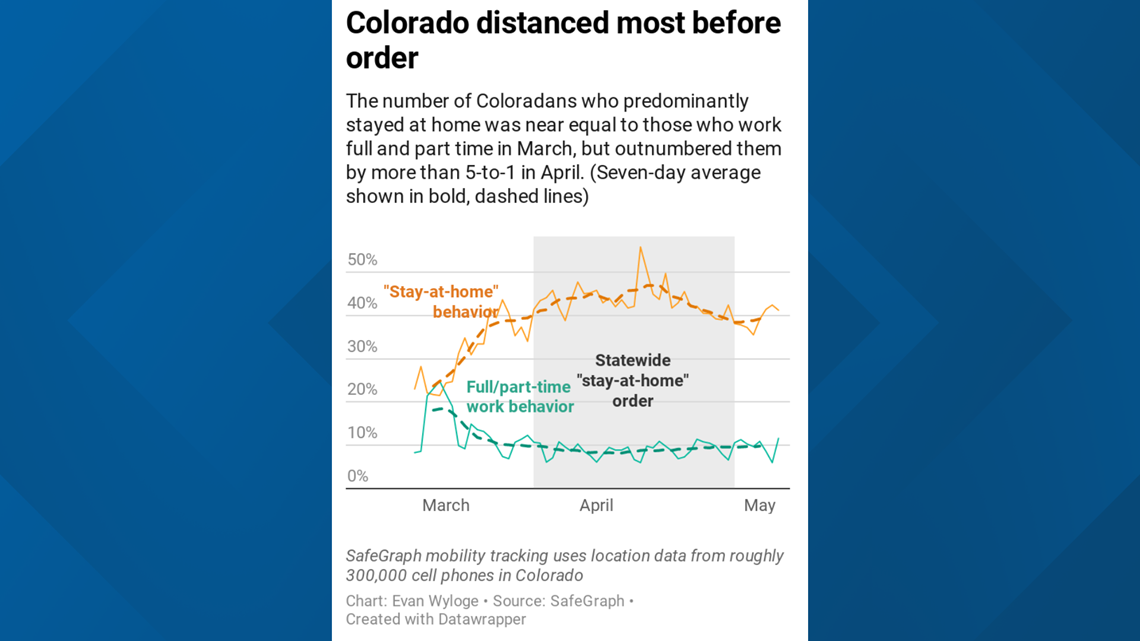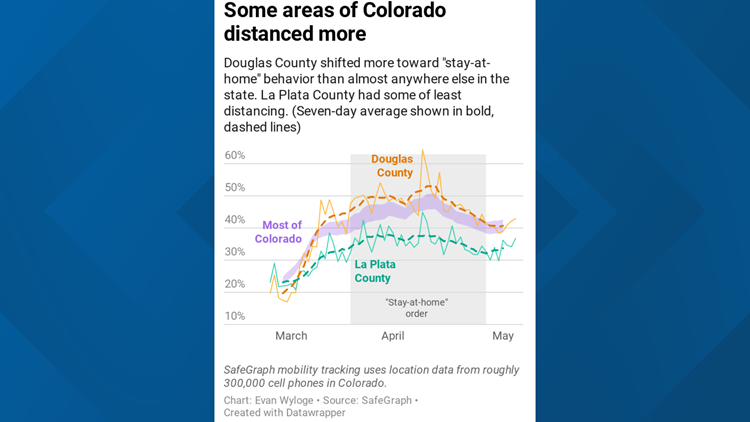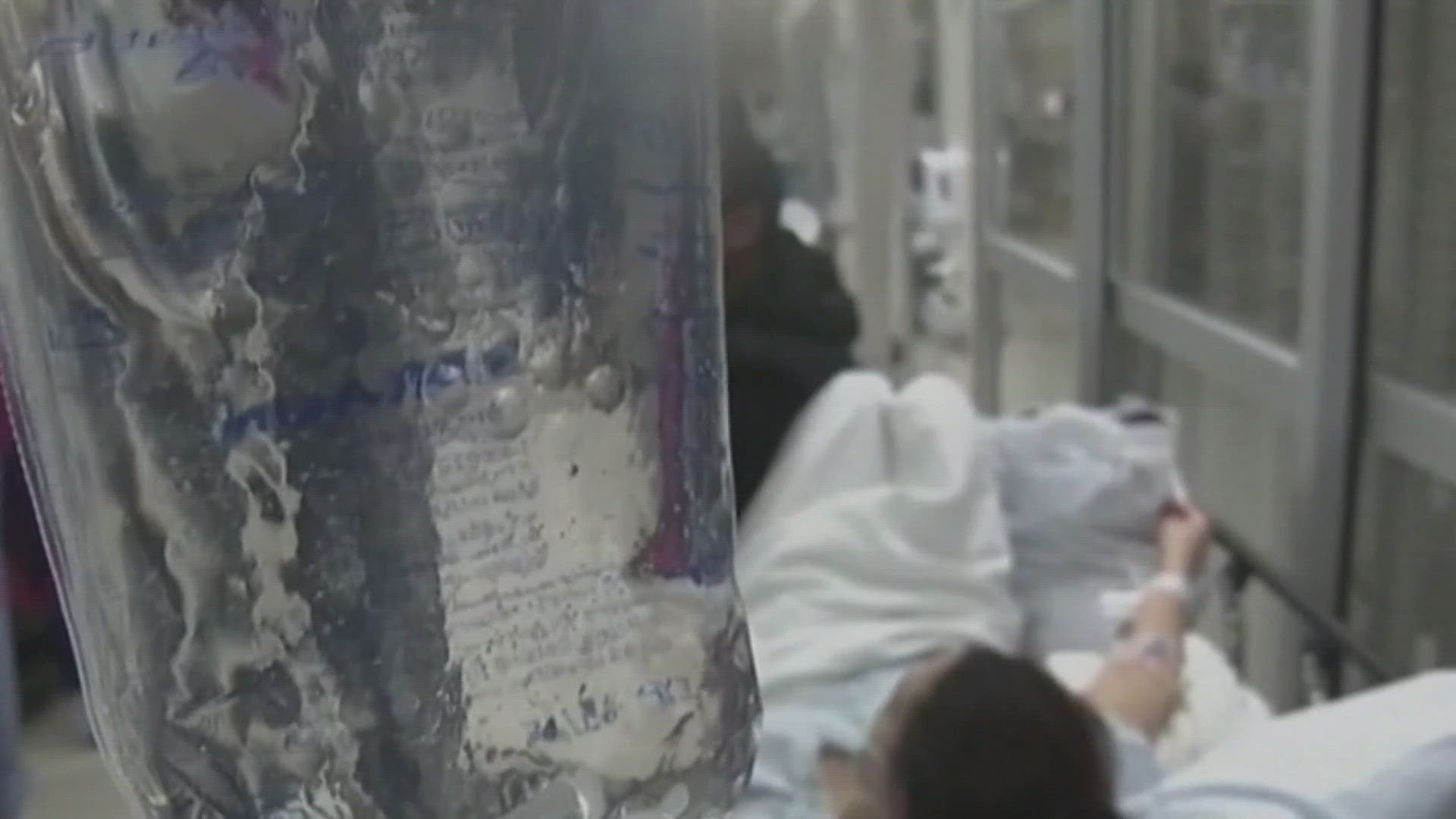Colorado’s statewide “stay-at-home” order began March 26 and lasted 32 tumultuous days. The spread of the novel coronavirus slowed, as hoped, but businesses shuttered, unemployment soared and protesters swarmed the Capitol demanding the state reopen.
Last week, opposition to the state’s restrictions turned into open defiance, as a Castle Rock restaurant reopened for dine-in customers on Mother’s Day, prompting the state health department to suspend its business license.
But routinely collected cellphone data shows Coloradans acted independently and in advance of the state’s orders during the past two months, distancing themselves before the statewide stay-at-home order and then partially easing back toward normal behavior prior to the state’s relaxation of the order on April 27.
The aggregated data, provided to The Gazette by the data clearinghouse company SafeGraph, shows the mobility patterns of Coloradans changed more and faster in the two weeks before Gov. Jared Polis’ announcement than it did during the 32-day order.
This story is powered by COLab, the Colorado News Collaborative. 9NEWS joined this historic collaboration with more than 40 other newsrooms across Colorado to better serve the public.


The portion of the roughly 300,000 tracked cellphones that matched SafeGraph’s “completely at home” behavior, meaning the phone never left a roughly 6-acre area for the day, rose from around 23% to about 40% before the stay-at-home order went into effect. That peaked around 50% on April 15.
And in the following two weeks, before the stay-at-home order was eased, the data shows Coloradans had reversed their shift toward stay-at-home behavior by about one-third, coming back down to roughly 40% staying home all day.
Polis and a group of University of Colorado researchers advising the state credit the reduction in social interactions in March and April for slowing the spread of the coronavirus. Where the number of known positive cases was doubling every two days in the first week of March, by the end of April, the case-doubling time slowed to 18 days.
In an April 20 report, the researchers estimated, based on the new case data, that Coloradans had reduced their social interactions between 75% and 78%.
Dr. Jonathan Samet, the UC School of Public Health dean and head of the research group, said the cellphone data reflects the social distancing his team inferred from the slowed growth of new cases, and reveals Coloradans’ incremental changes in mobility, which didn’t exactly line up with the orders.
“The data do show that behavior change began earlier than the various measures taken by the governor,” Samet wrote in an email, “likely reflecting rising understanding of the epidemic and the need to ‘shelter in place.’ Our campus essentially closed on March 13.”
The report also described a range of possible paths forward for the state, but predicted that a surge of cases surpassing hospital capacity over the coming months could only be avoided by maintaining a social interaction reduction of at least 55% to 65%, along with a combination of “complementary interventions,” such as wearing masks in public, improved testing and having older adults remain in a stay-at-home mode.
Even in the scenarios where hospital capacity isn’t exceeded, the number of active cases and deaths would remain relatively level for several months, meaning thousands more deaths, according to the April 20 report.
In a briefing Friday, Polis said it will take until about May 25 to determine whether the 55% to 65% social distancing target has been met.
The SafeGraph data was combined with data from Mapbox, by another group of partially overlapping researchers from Colorado State University and the University of Colorado to produce a report this week that showed the same trends.
A new report from a consortium of sources, which was provided to the state on May 9 and made public May 14, showed the same trends, concluding “people appeared to voluntarily reduce their time spent in public locations before recommended or required to do so and appear to have begun relaxing those reductions before the expiration of the stay-at-home order.” the report further concluded.
The report highlighted two areas where the cellular data showed less reduction of social interaction: Durango and Fort Collins.
“While Denver, Silverthorne and Steamboat Springs have seen declining activity throughout March,” the report stated, “the decline in Durango did not start until well into March. The decline in activity has been relatively slower in Fort Collins.”


In Douglas County, where the Castle Rock restaurant C&C Coffee and Kitchen opened on Mother’s Day in defiance of state orders, SafeGraph’s data shows residents changed behavior more than almost any others in the state. The portion of cellular devices categorized as stay-at-home behavior went from one of the lowest rates in the state in March to one of the highest by mid-April.
Higher-income Coloradans also distanced themselves more than those with lower incomes, the report provided to the governor found. The cellphone data, combined with census data, show that Coloradans living in areas where annual household income is greater than $100,000 per year spent more of their time at home than lower-income residents, and then distanced themselves more. Those living in areas with incomes below $25,000 had the lowest stay-at-home behavior, and distanced themselves the least during the state’s orders.
“These trends may reflect several important factors: people in higher-income households likely have more flexibility to work from home,” the report posits, “(while) people in lower-income households are more likely to be employed in essential industries, and the residents of lower-income households may also be experiencing higher rates of job loss. Further analysis is needed to disentangle these impacts, and the patterns will likely change over time as unemployment rises.”
The same cellphone data shows how badly restaurants have been hit by the attempts to slow the virus’ spread. Restaurants have lost more visits than any other type of business, and make up the largest portion of reduced physical visits from patrons, according to data provided by SafeGraph.
Restaurants, combined with shopping malls, parks and other recreational areas, account for half of the reduced social interactions, the SafeGraph data shows.
SUGGESTED VIDEOS: Local stories from 9NEWS


